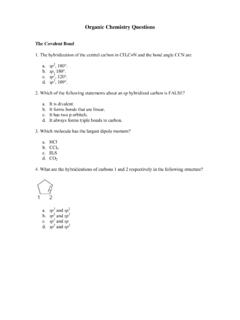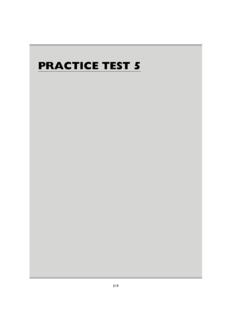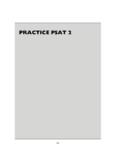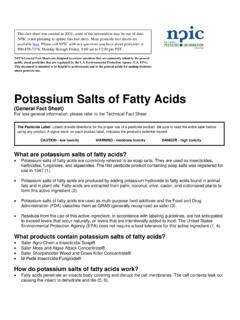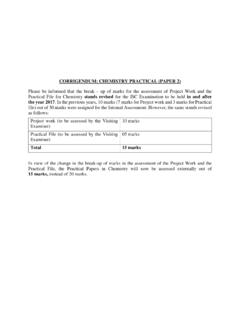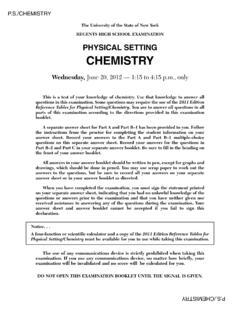Transcription of General Chemistry Questions - McGraw Hill Financial
1 General Chemistry Questions Electronic Structure and Periodic Table 1. What value or values of ml are allowable for an orbital with l = 2? a. 0 b. 2 c. -1 d. none of the above e. all of the above 2. According to Bohr Theory, which of the following transitions in the hydrogen atom will give rise to the least energetic photon? Use the equation: En = ( x 10-18 J)(1/n2) a. n = 5 to n = 3 b. n = 6 to n = 1 c. n = 4 to n = 3 d. n = 5 to n = 4 e. n = 6 to n = 5 3. Consider a 3dxz orbital. Which of the following statements is incorrect?
2 A. The xz plane is a nodal surface. b. The xz plane divides the electron probability distribution into two identical mirror-image halves. c. The xy plane divides the electron probability distribution into two identical mirror-image halves. d. The yz plane divides the electron probability distribution into two identical mirror-image halves. e. The nucleus is located at a node. 4. The electronic configuration of the element whose atomic number is 26 is: a. 1s2 2s2 2p6 3s2 3p6 4s0 3d8 b. 1s2 2s2 2p6 3s2 3p6 3d6 4s2 c.
3 1s2 2s2 2p6 3s2 3p6 4s2 3d6 d. 1s2 2s2 2p6 3s2 3p6 4s2 3d4 4p2 e. none of the above 5. Which of the following has the largest radius? a. F b. N c. C d. O e. Ne 6. Which of the following elements has the largest ionization energy? a. Na b. Ne c. F d. K e. Rb 7. Which of the following has the greatest electron affinity (most negative value)? a. Cl b. K c. He d. Na e. Rb 8. Which of the following species is not isolectronic with any of the others? a. V3+ b. Ca2+ c. Ar d. Cl- e. S2- 9. In Bohr's model of the hydrogen atom, the radius of an orbit a.
4 Is proportional to n2. b. is smallest for the highest energy state. c. increases when a photon of light is emitted from an excited atom. d. can have any value that is larger than the ground-state radius. e. none of the above 10. Which of the following atoms is not a one-electron system? a. H b. He+ c. Li2+ d. Be2+ e. O7+ 11. Which of the following statements about periodic properties is incorrect? a. Both electron affinity and ionization energy decrease down a group. b. Atomic size increases to the right across a period.
5 C. Ionization energy increases to the right across a period. d. Atomic size increases down a group. e. Electron affinity increases to the right across a period. Bonding 1. Which one of the following is most likely to be an ionic compound? a. HNF2 b. H2CO c. N2H4 d. CaCl2 e. CH3Cl 2. In which of the following processes does the enthalpy change ( H) directly represent the magnitude of the lattice energy of KCl(s)? a. Cl2(g) + 2K(s) 2 KCl(s) b. KCl(s) K+(aq) + Cl-(aq) c. KCl(s) K+(g) + Cl-(g) d.
6 KCl(s) K(s) + Cl-(g) e. KCl(s) K(s) + Cl(g) 3. Order the following by increasing bond strength: N N, N=N, N-N a. N N, N=N, N-N b. N N, N-N, N=N c. N-N, N=N, N N d. N=N, N-N, N N e. N=N, N N, N-N 4. Which of the following compounds has the greatest bond polarity? a. PH3 b. NH3 c. HF d. H2S e. CH4 5. Which of the following is not planar? a. BCl3 b. ClF3 c. PCl3 d. XeF4 e. C2H4 6. Use VSEPR theory to predict the ideal bond angles around the two carbon atoms in acetaldehyde, CH3 CHO. (The first carbon has single bonds to three H atoms and one C atom; the second carbon has single bonds to C and H, and a double bond to O.)
7 A. 109 , 109 b. 109 , 120 c. 120 , 109 d. 120 , 90 e. 105 , 105 7. In a carbon-carbon triple bond, what is the nature of the bonding between the carbons? a. two 2s orbitals overlapping b. two 2p orbitals overlapping c. two sp orbitals overlapping, two 2py overlapping and two 2pz overlapping d. an sp and sp2 overlapping and 2p orbitals overlapping e. an sp2 and sp2 overlapping and 2p orbitals overlapping 8. Which of the following molecules has sp3 hybridization and a dipole moment? a. SiH4 b. BF3 c.
8 NH3 d. BrF3 e. PCl5 9. In the molecular orbital description of bonding in benzene (C6H6), how many electrons occupy delocalized MOs? a. 2 b. 3 c. 4 d. 5 e. 6 10. In which of the following species is the octet rule violated by the central atom? a. CH4 b. SF4 c. PCl4+ d. SO2 e. NH3 11. The number of electron dots in the Lewis symbol for an element equals the a. number of outermost p electrons. b. number of electrons needed to fill the outermost p orbital. c. period number that contains the element.
9 D. number of outermost s and p electrons. e. number of outermost s electrons. Phases and Phase Equilibria 1. Calculate the pressure of mol of NH3 gas in a L vessel at 25 C, using the ideal gas law. a. atm b. atm c. atm d. atm e. atm 2. A steel tank contains carbon dioxide at 34 C and is at a pressure of atm. Determine the internal gas pressure when the tank and its contents are heated to 100 C. a. atm b. atm c. atm d. atm e. atm 3. Deviations from the ideal gas law are less at: a.
10 High temperatures and high pressures b. high temperatures and low pressures c. low temperatures and high pressures d. low temperatures and low pressures e. high volumes and low temperatures 4. A mixture of three gases has a pressure of 1380 mmHg at at 298 K. The mixture is analyzed and is found to contain mol CO2, mol CO, and mol Ar. What is the partial pressure of Ar? a. 238 mm Hg b. 302 mm Hg c. 356 mm Hg d. 1753 mm Hg e. 8018 mm Hg 5. Which of the following exhibits the most hydrogen bonding?
